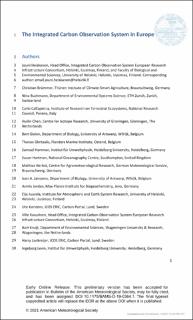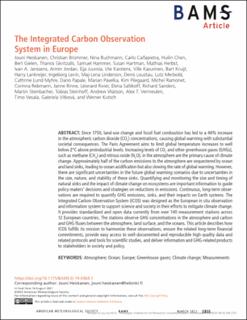| dc.contributor.author | Heiskanen, Jouni | |
| dc.contributor.author | Brümmer, Christian | |
| dc.contributor.author | Buchmann, Nina | |
| dc.contributor.author | Calfapietra, Carlo | |
| dc.contributor.author | Chen, Huilin | |
| dc.contributor.author | Gielen, Bert | |
| dc.contributor.author | Gkritzalis, Thanos | |
| dc.contributor.author | Hammer, Samuel | |
| dc.contributor.author | Hartman, Susan | |
| dc.contributor.author | Herbst, Mathias | |
| dc.contributor.author | Janssens, Ivan A. | |
| dc.contributor.author | Jordan, Armin | |
| dc.contributor.author | Juurola, Eija | |
| dc.contributor.author | Karstens, Ute | |
| dc.contributor.author | Kasurinen, Ville | |
| dc.contributor.author | Kruijt, Bart | |
| dc.contributor.author | Lankreijer, Harry | |
| dc.contributor.author | Levin, Ingeborg | |
| dc.contributor.author | Linderson, Maj-Lena | |
| dc.contributor.author | Loustau, Denis | |
| dc.contributor.author | Merbold, Lutz | |
| dc.contributor.author | Myhre, Cathrine Lund | |
| dc.contributor.author | Papale, Dario | |
| dc.contributor.author | Pavelka, Marian | |
| dc.contributor.author | Pilegaard, Kim | |
| dc.contributor.author | Ramonet, Michel | |
| dc.contributor.author | Rebmann, Corinna | |
| dc.contributor.author | Rinne, Janne | |
| dc.contributor.author | Rivier, Leonard | |
| dc.contributor.author | Saltikoff, Elena | |
| dc.contributor.author | Sanders, Richard | |
| dc.contributor.author | Steinbacher, Martin | |
| dc.contributor.author | Steinhoff, Tobias | |
| dc.contributor.author | Watson, Andrew | |
| dc.contributor.author | Vermeulen, Alex T. | |
| dc.contributor.author | Vesala, Timo | |
| dc.contributor.author | Vitkova, Gabriela | |
| dc.contributor.author | Kutsch, Werner | |
| dc.date.accessioned | 2022-06-01T08:15:36Z | |
| dc.date.available | 2022-06-01T08:15:36Z | |
| dc.date.created | 2021-11-09T14:13:49Z | |
| dc.date.issued | 2021 | |
| dc.identifier.citation | Bulletin of The American Meteorological Society - (BAMS). 2021, . | en_US |
| dc.identifier.issn | 0003-0007 | |
| dc.identifier.uri | https://hdl.handle.net/11250/2997159 | |
| dc.description.abstract | Since 1750, land use change and fossil fuel combustion has led to a 46 % increase in the atmospheric carbon dioxide (CO2) concentrations, causing global warming with substantial societal consequences. The Paris Agreement aims to limiting global temperature increases to well below 2°C above pre-industrial levels. Increasing levels of CO2 and other greenhouse gases (GHGs), such as methane (CH4) and nitrous oxide (N2O), in the atmosphere are the primary cause of climate change. Approximately half of the carbon emissions to the atmosphere is sequestered by ocean and land sinks, leading to ocean acidification but also slowing the rate of global warming. However, there are significant uncertainties in the future global warming scenarios due to uncertainties in the size, nature and stability of these sinks. Quantifying and monitoring the size and timing of natural sinks and the impact of climate change on ecosystems are important information to guide policy-makers’ decisions and strategies on reductions in emissions. Continuous, long-term observations are required to quantify GHG emissions, sinks, and their impacts on Earth systems. The Integrated Carbon Observation System (ICOS) was designed as the European in situ observation and information system to support science and society in their efforts to mitigate climate change. It provides standardized and open data currently from over 140 measurement stations across 12 European countries. The stations observe GHG concentrations in the atmosphere and carbon and GHG fluxes between the atmosphere, land surface and the oceans. This article describes how ICOS fulfills its mission to harmonize these observations, ensure the related long-term financial commitments, provide easy access to well-documented and reproducible high-quality data and related protocols and tools for scientific studies, and deliver information and GHG-related products to stakeholders in society and policy. | en_US |
| dc.language.iso | eng | en_US |
| dc.rights | Navngivelse 4.0 Internasjonal | * |
| dc.rights.uri | http://creativecommons.org/licenses/by/4.0/deed.no | * |
| dc.title | The Integrated Carbon Observation System in Europe | en_US |
| dc.type | Journal article | en_US |
| dc.type | Peer reviewed | en_US |
| dc.rights.holder | © 2022 American Meteorological Society | en_US |
| dc.description.version | publishedVersion | en_US |
| cristin.ispublished | true | |
| cristin.fulltext | postprint | |
| cristin.qualitycode | 2 | |
| dc.identifier.doi | 10.1175/BAMS-D-19-0364.1 | |
| dc.identifier.cristin | 1952812 | |
| dc.source.journal | Bulletin of The American Meteorological Society - (BAMS) | en_US |
| dc.source.pagenumber | 54 | en_US |
| dc.relation.project | EC/FP7/211574 | en_US |
| dc.relation.project | EC/H2020/730944 | en_US |
| dc.relation.project | Klima- og miljødepartementet: * | en_US |
| dc.relation.project | Miljødirektoratet: * | en_US |


